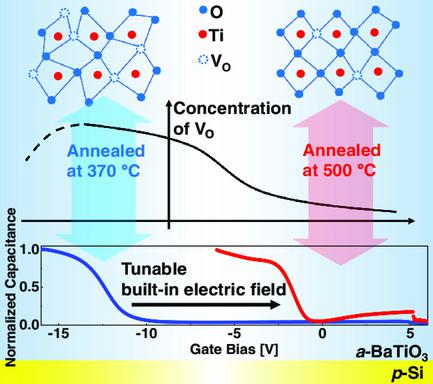当前位置:
X-MOL 学术
›
Phys. Status Solidi A
›
论文详情
Our official English website, www.x-mol.net, welcomes your feedback! (Note: you will need to create a separate account there.)
Control of Oxygen Vacancies in TiO6 Octahedra of Amorphous BaTiO3 Thin Films with Tunable Built‐In Electric Field in a‐BaTiO3/p‐Si Heterojunction for Metal–Oxide–Semiconductor Applications
Physica Status Solidi (A) - Applications and Materials Science ( IF 2 ) Pub Date : 2020-04-21 , DOI: 10.1002/pssa.201900941 Jian Gu 1 , Wei Tian 1 , Zongrong Wang 1 , Ning Ma 1 , Piyi Du 1
Physica Status Solidi (A) - Applications and Materials Science ( IF 2 ) Pub Date : 2020-04-21 , DOI: 10.1002/pssa.201900941 Jian Gu 1 , Wei Tian 1 , Zongrong Wang 1 , Ning Ma 1 , Piyi Du 1
Affiliation

|
Amorphous BaTiO3 (a ‐BTO) thin films are deposited on p ‐Si(111) substrates by radio frequency (RF) magnetron sputtering without extra substrate heating. The microstructure of a ‐BTO thin films is modified by postannealing at low temperatures (260–600 °C) in air. The results show that distorted TiO6 octahedra exist in a ‐BTO thin films, and the degree of distortion decreases when the annealing temperature rises. The concentration of O vacancies in the TiO6 of the thin films remains high when postannealed between 370 and 460 °C, and a built‐in electric field across the a ‐BTO/p ‐Si heterojunction is established in this annealing temperature range. This built‐in electric field is regulated by controlling the concentration of O vacancies from the TiO6. The tunable C–V characteristic of the Au/a ‐BTO/p ‐Si metal–oxide–semiconductor (MOS) capacitor is obtained by modulating the built‐in electric field at the heterojunction, and the flat band voltage of the MOS capacitor shifts from about −3 V to at least −13 V when the postannealing temperature increases from 260 to 420 °C. This kind of tunable built‐in electric field at the a ‐BTO/p ‐Si heterojunction, controlled by modifying the microstructure of amorphous oxide thin films, has never been observed before, which will be useful for MOS applications.
中文翻译:

用于金属-氧化物-半导体应用的a-BaTiO3 / p-Si异质结中具有可调内置电场的非晶BaTiO3薄膜的TiO6八面体中氧空位的控制
通过射频(RF)磁控溅射将非晶BaTiO 3(a- BTO)薄膜沉积在p- Si(111)衬底上,而无需额外的衬底加热。的显微组织一-BTO薄膜是通过在空气中在低温(260-600℃)后续退火修改。结果表明,二氧化钛扭曲6在八面体存在一个-BTO薄膜,并且当退火温度的升高失真的程度降低。在使TiOø空位浓度6 370和460℃之间postannealed当薄膜仍然很高,和一个内置的电场横跨一个-BTO / p在此退火温度范围内建立了Si异质结。通过控制来自TiO 6的O空位的浓度可以调节这种内置电场。Au / a- BTO / p -Si金属氧化物半导体(MOS)电容器的可调C–V特性是通过调制异质结处的内置电场获得的,并且MOS电容器的平带电压偏移当后退火温度从260°C升高到420°C时,温度从大约-3V降低到至少-13V。这种可调谐的内建电场在一个-BTO / p通过改变非晶氧化物薄膜的微观结构来控制的Si异质结从未见过,这对于MOS应用很有用。
更新日期:2020-04-21
中文翻译:

用于金属-氧化物-半导体应用的a-BaTiO3 / p-Si异质结中具有可调内置电场的非晶BaTiO3薄膜的TiO6八面体中氧空位的控制
通过射频(RF)磁控溅射将非晶BaTiO 3(a- BTO)薄膜沉积在p- Si(111)衬底上,而无需额外的衬底加热。的显微组织一-BTO薄膜是通过在空气中在低温(260-600℃)后续退火修改。结果表明,二氧化钛扭曲6在八面体存在一个-BTO薄膜,并且当退火温度的升高失真的程度降低。在使TiOø空位浓度6 370和460℃之间postannealed当薄膜仍然很高,和一个内置的电场横跨一个-BTO / p在此退火温度范围内建立了Si异质结。通过控制来自TiO 6的O空位的浓度可以调节这种内置电场。Au / a- BTO / p -Si金属氧化物半导体(MOS)电容器的可调C–V特性是通过调制异质结处的内置电场获得的,并且MOS电容器的平带电压偏移当后退火温度从260°C升高到420°C时,温度从大约-3V降低到至少-13V。这种可调谐的内建电场在一个-BTO / p通过改变非晶氧化物薄膜的微观结构来控制的Si异质结从未见过,这对于MOS应用很有用。


























 京公网安备 11010802027423号
京公网安备 11010802027423号